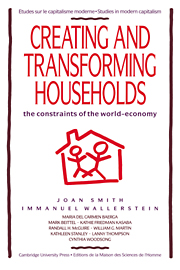Book contents
- Frontmatter
- Contents
- Preface
- I INTRODUCTION
- II THE UNITED STATES
- Introduction
- 1 The Detroit story: the crucible of Fordism
- 2 New York City: the underside of the world's capital
- 3 Binghamton: the secrets of a backwater
- 4 Puerto Rico: from colony to colony
- III MEXICO
- IV SOUTHERN AFRICA
- V CONCLUSION
- A postscript on method
- References
- Index
- Studies in Modern Capitalism
4 - Puerto Rico: from colony to colony
Published online by Cambridge University Press: 07 June 2010
- Frontmatter
- Contents
- Preface
- I INTRODUCTION
- II THE UNITED STATES
- Introduction
- 1 The Detroit story: the crucible of Fordism
- 2 New York City: the underside of the world's capital
- 3 Binghamton: the secrets of a backwater
- 4 Puerto Rico: from colony to colony
- III MEXICO
- IV SOUTHERN AFRICA
- V CONCLUSION
- A postscript on method
- References
- Index
- Studies in Modern Capitalism
Summary
The island of Puerto Rico was a Spanish colony from the fifteenth century to the very end of the nineteenth century. In 1898, as a consequence of the Spanish-American War, Puerto Rico became a “territorial possession” – a colony– of the United States. For the purposes of this analysis, we are considering Puerto Rico as a local region within the United States, at least after 1898. In 1917, Puerto Ricans were granted US citizenship. In 1952, Puerto Rico officially became a “Free Associated State” (Estado Libre Asociado), a kind of commonwealth with some political autonomy in local affairs, but subject to US federal law without congressional representation.
Throughout the nineteenth century, the island's economy was oriented toward export agricultural production, alternatively sugar and coffee. The last quarter of the century saw some growth and technological innovation of the sugar haciendas, but overall production languished under Spain's mercantilist restrictions. Coffee exports fared somewhat better, and expanded in response to European demand. Coffee production was based upon a mix of medium-sized haciendas, some of which incorporated technical innovations in the processing stage, and small-scale producers, using family labor in cultivation and harvest. By the end of the century, however, many small-scale producers had succumbed to competition and indebtedness and were gradually integrated as semi-servile labor in the haciendas (Dietz, 1986: 64–69).
Throughout most of the nineteenth century, landowners voiced complaints about the lack of workers for commercial production.
- Type
- Chapter
- Information
- Creating and Transforming HouseholdsThe Constraints of the World-Economy, pp. 121 - 142Publisher: Cambridge University PressPrint publication year: 1992
- 2
- Cited by



